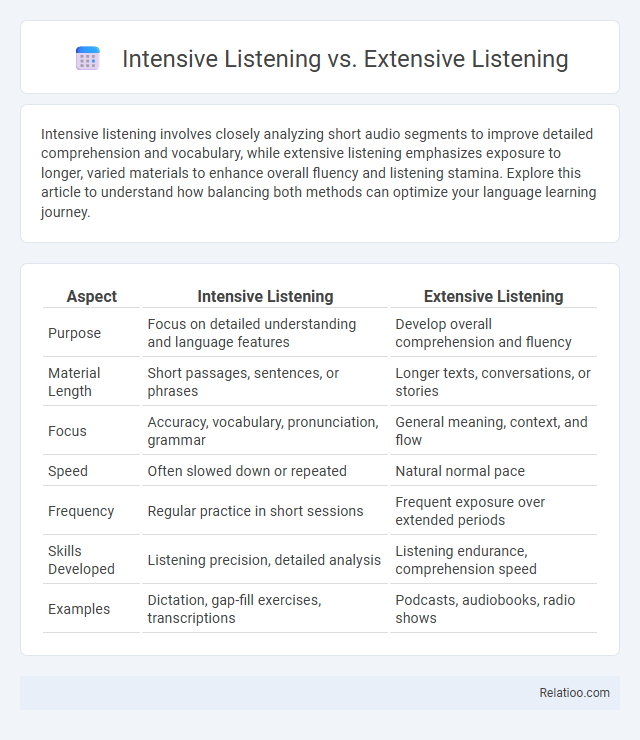Intensive listening involves closely analyzing short audio segments to improve detailed comprehension and vocabulary, while extensive listening emphasizes exposure to longer, varied materials to enhance overall fluency and listening stamina. Explore this article to understand how balancing both methods can optimize your language learning journey.
Table of Comparison
| Aspect | Intensive Listening | Extensive Listening |
|---|---|---|
| Purpose | Focus on detailed understanding and language features | Develop overall comprehension and fluency |
| Material Length | Short passages, sentences, or phrases | Longer texts, conversations, or stories |
| Focus | Accuracy, vocabulary, pronunciation, grammar | General meaning, context, and flow |
| Speed | Often slowed down or repeated | Natural normal pace |
| Frequency | Regular practice in short sessions | Frequent exposure over extended periods |
| Skills Developed | Listening precision, detailed analysis | Listening endurance, comprehension speed |
| Examples | Dictation, gap-fill exercises, transcriptions | Podcasts, audiobooks, radio shows |
Introduction to Intensive and Extensive Listening
Intensive listening targets detailed understanding of specific audio segments, enhancing vocabulary and pronunciation through focused practice. Extensive listening emphasizes exposure to longer, varied audio materials to improve overall fluency and comprehension. Both strategies complement each other to build effective listening skills essential for language acquisition.
Defining Intensive Listening
Intensive listening involves careful, focused attention to short audio segments to analyze details such as pronunciation, vocabulary, and grammar, enhancing specific language skills. Extensive listening emphasizes exposure to longer, varied audio materials to develop overall fluency and comprehension in a natural context. Comprehension in listening refers to the ability to understand and interpret spoken language, integrating both intensive and extensive listening strategies for effective communication.
Defining Extensive Listening
Extensive listening involves engaging with large amounts of audio input at a comfortable level to enhance overall language proficiency without focusing on every detail, promoting natural language acquisition. Intensive listening requires detailed attention to specific segments, improving accuracy and comprehension of complex texts. Your practice benefits from incorporating extensive listening to build fluency and develop a better understanding of context before moving to intensive listening and comprehension exercises.
Key Differences Between Intensive and Extensive Listening
Intensive listening involves focused, detailed analysis of short audio segments to understand specific language features, vocabulary, and grammar, while extensive listening emphasizes exposure to longer, authentic materials for general understanding and fluency development. Comprehension plays a central role in both, but intensive listening targets precision and accuracy, whereas extensive listening fosters overall listening stamina and contextual learning. The key difference lies in the purpose: intensive listening aims for deep linguistic accuracy, extensive listening prioritizes broad, natural language exposure.
Benefits of Intensive Listening
Intensive listening enhances detailed understanding by focusing on specific language elements such as vocabulary, grammar, and pronunciation, leading to improved accuracy and retention. It promotes active engagement with audio materials, facilitating deeper cognitive processing and language acquisition compared to extensive listening's broader exposure. Intensive listening also aids in developing critical listening skills essential for academic and professional contexts, boosting overall comprehension and communication proficiency.
Benefits of Extensive Listening
Extensive listening involves engaging with a wide range of audio materials at a comfortable level, enhancing your overall language fluency and natural comprehension skills. This approach increases exposure to diverse accents, vocabulary, and contexts, thereby reinforcing intuitive understanding rather than relying on detailed analysis. Your ability to grasp the main ideas and improve listening stamina benefits significantly from consistent extensive listening practice.
Suitable Contexts for Intensive Listening
Intensive listening is best suited for academic settings, language learning classrooms, and situations requiring detailed understanding of specific language features such as pronunciation, grammar, and vocabulary. This mode emphasizes careful and focused attention on short audio segments to improve listening accuracy and comprehension skills. Extensive listening, by contrast, benefits contexts like daily conversation practice or language immersion where exposure to a variety of speakers and informal language fosters overall fluency and natural comprehension.
Effective Scenarios for Extensive Listening
Extensive listening is most effective in scenarios where You aim to build overall language fluency and improve comprehension through exposure to varied, authentic audio materials like podcasts, movies, or radio. Unlike intensive listening, which involves detailed analysis of shorter passages for accuracy, extensive listening supports natural language acquisition by promoting contextual understanding and vocabulary growth over time. Its effectiveness peaks when used in relaxed environments, allowing repeated exposure without pressure to understand every detail.
Combining Intensive and Extensive Listening in Language Learning
Combining intensive and extensive listening enhances your language learning by developing both detailed understanding and overall fluency. Intensive listening focuses on closely analyzing specific audio segments to improve vocabulary and grammar, while extensive listening involves engaging with longer, varied content to build natural comprehension and listening stamina. Integrating these methods results in a balanced skill set, accelerating your ability to understand and respond effectively in real-life conversations.
Choosing the Right Listening Approach for Your Goals
Intensive listening involves carefully analyzing short audio segments to improve detailed understanding and language accuracy, while extensive listening prioritizes exposure to larger amounts of natural speech for fluency and general comprehension. Comprehension combines both methods to develop a balanced listening skill set, enabling you to grasp meaning in diverse contexts. Choosing the right listening approach depends on your specific goals, whether it's mastering details, building overall listening stamina, or enhancing practical communication skills.

Infographic: Intensive Listening vs Extensive Listening
 relatioo.com
relatioo.com